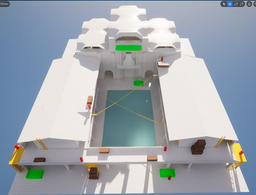Preview
Pre-Production
Historical accuracy is critical in all Assassin's Creed games. I looked up some layouts and blueprints of Rome's bath that fit the historical background in the game. I tried to find the architecture that could be used at a game level. I began my process by gathering inspiring images. My reference library consisted of images of screenshots from the game, historical images, and actual photos.
Historical accuracy
I researched the character's height and then used his height as a reference to "eyeball" all the objects in the game. In this case, I set up a unified metric system. Based on my measurements, I recreated a smaller part from the level to test my measurements and adjust sizes.
Define Metrics from the game


By analyzing the game I learned that when the player enters the enemy-controlled space, the player will reach a space called a safe zone, where the player can stay hidden and observe the layout.
Design Language
I realize that in AAA games there are a lot of re-used assets. This is a good technique to be more efficient in game development. So I planned out the modulated pieces I needed to assemble the level and pre-assembled them to test out the metrics.
Modulate Consideration


Iterations
Flow Chart

Design Techniques

For an open-world level, the pacing is changed from a linear experience to a more circular experience. From the out range to the inner range, there are a lot of events that players could encounter, but the overall tension and excitement are still building up in a linear way based on the player's choices. In this case, the player feels having more control in the world while their experience can be quantified and managed by a level designer.
Give the control to the player

This is an abstract flowchart showing how circular pacing corresponds with linear pacing but provides more choices. Each point is an event that simulates different emotions. The green points are more chill and peaceful events, while the yellow points are a bit intense, and the red points are the climax of the level. At an open-world level, we cannot force players to take specific paths but we can predict and attract players with ranged POIs.
"Onion-layer" level progression

Gameplay Development
I am using overlapping detection to trigger events related to the enemy, for example, hearing range, vision cone, assassination range, and related UI displacement logic.

I expanded and developed many features for the controller, including crouching with hidden effects, eagle vision, assassination, and level manager.

I also implemented a basic collectible system so that the player could collect clues in the game.

Conclusion
In this project, I was trying to design a stealth level in Assassin's Creed's style. I learned a lot when analyzing the game metrics and why the developer made such choices. I started to think more critically and shift my view from the player's perspective to an AAA game developer. I am glad I made some progress before GDC and I had a chance to playtest it with some industry professionals. They provide me with tons of great feedback and help me improve more. Of course, this project isn't perfect, if I have more time I would like to spend some time working on the enemy AI and quest system. This is just half of the whole quest. I want to let the player discover the target's identity in the daytime and come back in the nighttime to assassinate the target.










































